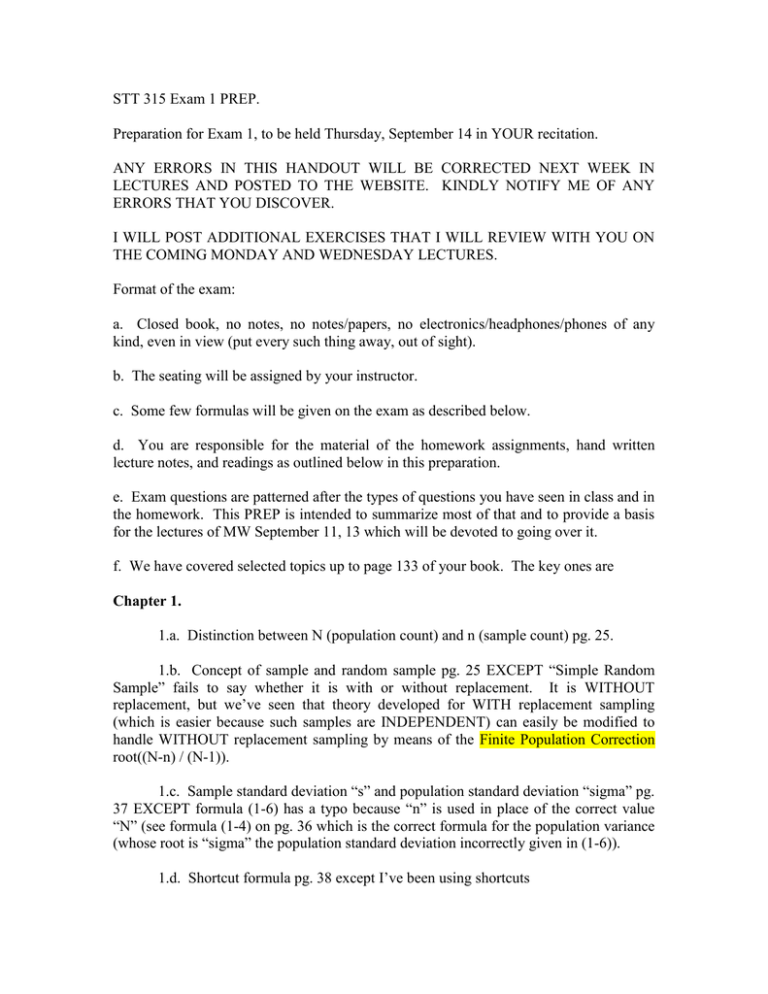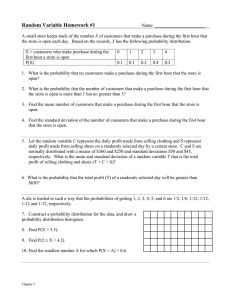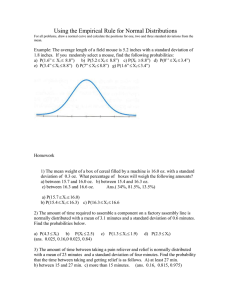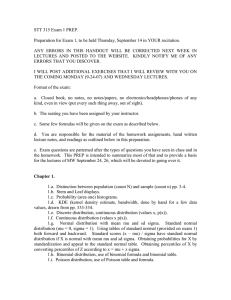STT 315 Exam 1 PREP.
advertisement

STT 315 Exam 1 PREP.
Preparation for Exam 1, to be held Thursday, September 14 in YOUR recitation.
ANY ERRORS IN THIS HANDOUT WILL BE CORRECTED NEXT WEEK IN
LECTURES AND POSTED TO THE WEBSITE. KINDLY NOTIFY ME OF ANY
ERRORS THAT YOU DISCOVER.
I WILL POST ADDITIONAL EXERCISES THAT I WILL REVIEW WITH YOU ON
THE COMING MONDAY AND WEDNESDAY LECTURES.
Format of the exam:
a. Closed book, no notes, no notes/papers, no electronics/headphones/phones of any
kind, even in view (put every such thing away, out of sight).
b. The seating will be assigned by your instructor.
c. Some few formulas will be given on the exam as described below.
d. You are responsible for the material of the homework assignments, hand written
lecture notes, and readings as outlined below in this preparation.
e. Exam questions are patterned after the types of questions you have seen in class and in
the homework. This PREP is intended to summarize most of that and to provide a basis
for the lectures of MW September 11, 13 which will be devoted to going over it.
f. We have covered selected topics up to page 133 of your book. The key ones are
Chapter 1.
1.a. Distinction between N (population count) and n (sample count) pg. 25.
1.b. Concept of sample and random sample pg. 25 EXCEPT “Simple Random
Sample” fails to say whether it is with or without replacement. It is WITHOUT
replacement, but we’ve seen that theory developed for WITH replacement sampling
(which is easier because such samples are INDEPENDENT) can easily be modified to
handle WITHOUT replacement sampling by means of the Finite Population Correction
root((N-n) / (N-1)).
1.c. Sample standard deviation “s” and population standard deviation “sigma” pg.
37 EXCEPT formula (1-6) has a typo because “n” is used in place of the correct value
“N” (see formula (1-4) on pg. 36 which is the correct formula for the population variance
(whose root is “sigma” the population standard deviation incorrectly given in (1-6)).
1.d. Shortcut formula pg. 38 except I’ve been using shortcuts
s = root(n / (n-1)) root(mean of squares – square of mean)
sigma =root(mean of squares – square of mean)
These shortcut or computing formulas are much more susceptible to rounding errors than
are the formulas (1-5) and (corrected) (1-6). We use them as a convenience in hand
calculations.
1.e. “Margin of Error” +/- 1.96 sigma / root(n), except we use its estimate
+/- 1.96 s / root(n)
since the population standard deviation sigma is usually not known and has to be
estimated using the sample standard deviation s. Take a peek at expression (6-2) on pg.
246. The main interpretation of margin of error is offered by
P( mu is covered by xBAR +/- 1.96 s / root(n) ) ~ 0.95
which says that around 95% of with-replacement samples will be such that the interval
formed from them by the recipe xBAR +/- 1.96 s / root(n) will cover the true population
mean mu. Thus the margin of error provides a means of enlarging our estimate xBAR
into an interval xBAR +/- margin of error having around 95% chance of enclosing the
true population mean mu. This (random) interval xBAR +/- 1.96 s / root(n) is given the
name “95% confidence interval for mu.” Take a peek at the solution of EXAMPLE 6-3
pg. 256 EXCEPT that capital “S” in expression (6-6) should be lower case “s” (the
sample standard deviation). For sampling WITHOUT replacement we have
P( mu is covered by xBAR +/- 1.96 s / root(n) FPC ) ~ 0.95
where FPC denotes the finite population correction root((N-n) / (N-1)).
Chapter 2.
2.a. What I’ve called “Classical Probability” modeled by equally likely possible
outcomes, universal set (or “Sample Space”) capital S, probabilities defined by (2-1) pg.
80. Examples: red and green dice, coins, colored balls, Jack/Jill (from lectures).
2b. Basic rules for probability (section 2-2), complements (not = overbar =
superscript “C”, for which see (2-3) pg. 83.
Addition rule for probabilities
P(A union B) = P(A) + P(B) – P(A intersection B)
i.e. P(A or B) = P(A) + P(B) – P(A and B)
for which see “rule of unions” pg. 84, expression (2-4) EXCEPT I want you to see this in
connection with the Venn diagram.
Multiplication rule for probabilities
P(A and B) = P(A) P(B | A)
with the conditional probability P(B | A) defined by
P(B | A) = P(A and B) / P(A) = P(AB) / P(A).
It is motivated in the Classical Equally Likely setup from
P(AB) = #(AB) / #(S) = {#(A) / #(S)} {#(AB) / #(A)}
where {#(A) / #(S)} is just P(A) and {#(AB) / #(A)} has the natural interpretation of
“conditional probability of B if we know that the outcome is in A.”
Why the addition and multiplication rules are adopted as AXIOMS for all our studies
even if all outcomes are not equally probable. Loosely put: It is because such rules are
preserved when we derive any probability model from another one using the rules and
also the rules must apply if our probabilities are to conform to real world counts (since
counts are the basis for classical probabilities).
Independence of events. The definition is “A independent of B if P(AB) = P(A) P(B).”
A better way to think of it is P(B | A) = P(B), meaning that the probability for event B is
not changed when A is known to have occurred. See expressions (2-9) and (2-10) pg. 92.
It may be shown that a is independent of B if an only if each of
B independent of A
AC independent of B etc. in all combinations
In short, nothing learned about the one changes the probability for the other.
Independence of events and random variables is a hugely important concept in statistics.
See Intersection Rule pg. 93.
Law of Total Probability. Total probability breaks down an event into its overlay with
other (mutually disjoint) events, see (2-14) pg. 99. For example, the probability I will
realize at least 1000% return on my investment is the sum of the two probabilites for
hotel built nearby and I realize at least 1000%
hotel not built nearby and I realize at least 1000%
Similarly, in WITHOUT replacement and equal probability draws from a box containing
colored balls [ B B B B R R G Y Y Y ],
P(B2) = P(B1 B2) + P(R1 B2) + P(G1 R2) + P(Y1 B2)
= P(B1 B2) + P(B1C B2)
While both forms above are correct, and give the same answer for P(B2), it is easier to
work with the second one (after all, as regards B2, the only thing that matters from the
first draw is whether or not a black was drawn).
Law of Total Probability coupled with multiplication rule. Taking the example just
above
P(B2) = P(B1 B2) + P(B1C B2) total probability
= P(B1) P(B2 | B1) + P(B1C) P(B2 | B1C)
= 4/10 3/9 + 6/10 4/9 = (12 + 24)/(10 9) = 4/10
This gives P(B2) = 4/10 which is the same as P(B1). It must be so because of “order of
the deal does not matter.”
Bayes’ Theorem. It is really just the definition of conditional probability in a special
context. Bayes’ idea was to update probabilities as new information is received. He
possibly found it exciting to have hit on the way to do it while at the same time having
misgivings at how simple it really was. In the end he did not publish the very work he is
most universally known for. I like the OIL example set in the contest of trees but you
may memorize the formula (2-22) pg. 103 if you wish. You can see that formula (2-22)
requires us to know some probabilities P(Bi) and some conditional probabilities P(A | Bi).
Set in the OIL example it goes like this:
e.g.
P(OIL) = 0.2, P(+ | OIL) = 0.9, P(+ | OIL) = 0.3 are given
This gives a tree with root probabilities
P(OIL) = 0.2
P(OILC) = 1 – 0.2 = 0.8
Down-stream branch probabilities are (by convention) conditional
+ 0.9
OIL+ 0.2 0.9
OIL 0.2
- 0.1
OIL- 0.2 0.1
C
+ 0.3
OILC+ 0.8 0.3
- 0.7
OILC+ 0.8 0.7
OIL 0.8
This leads to P(+) = 0.2 0.9 + 0.8 0.3 (total probability and multiplication).
So Bayes’ P(OIL | +) = P(OIL+) / P(+) = 0.2 0.9 / [0.2 0.9 + 0.8 0.3].
You can use formula (2-22) to get this answer with
A = OIL
B1 = +
B2 = See figure (2-14) pg. 105 for this presentation.
Random variables, expectation, variance, standard deviation. This is chapter 3. A
key feature is the probability distribution of random variable X. It lists the possible
values x together with their probabilities p(x). As an example, suppose sales of one of
three options for a dessert. Let X denote the price of a (random) purchase. Suppose the
costs of the three options are 1, 1.5, 2 (dollars) with respective probabilities 0.2, 0.3, 0.5.
These reflect the relative frequencies with which our customers purchase these options.
We then have
x p(x)
x2 p(x)
x
p(x)
1
0.2
1 (0.2) = 0.2
12 (0.2) = 0.2
1.5
0.3
1.5 (0.3) = 0.45
1.52 (0.3) = 0.675
2
0.5
2 (0.5) = 1
22 (0.5) = 2
_________________________________________
totals
1.0
E X = 1.65
E X2 = 2.875
From this we find Variance X = Var X = E X2 – (E X)2 = 2.875 – 1.652 = 0.1525 and
standard deviation of X = root(Var X) = root( 0.1525) = 0.39 (39 cents).
Rules for expectation, variance and sd of r.v. The easiest way to understand the role of
the rules is to see what they have to say about the total returns from many
INDEPENDENT purchases. Suppose we make 900 INDEPENDENT sales from this
distribution. Let T = X1 + .... + X900 denote these random sales amounts. Then
E T = E X1 + ... + E X900 = 900 (1.65) = 1485 (dollars)
Var T = Var X1 + ..... + Var X900 because sales are INDEPENDENT
= 900 0.1525 = 137.25
sd T = root(Var T) = root(137.25) = 11.715 (dollars).
Later in this course we will advance reasons which T should be approximately normally
distributed. So total sales T, in dollars, is approximately distributed as a bell (normal)
curve with mean $1,485 and sd = $11.71. So around 95% of the time the random total
sales T would fall within $(1,485 +/- 1.96 11.71).
The key rules for expectation and variance and standard deviation are found in displays
on pg. 133.






